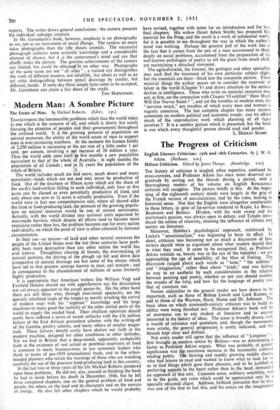Photography as Art
Masterpieces of Victorian Photography. By Helmut Gemsheim. (Phaidon Press. 2 ss.) DU1UNG the past summer a-small exhibition in the Victoria and Albert Museum brought home for the first time to many the achieve- ments of Victorian photographers. Professionals, and those whose work is connected with photography, have long known and admired the pictures taken by D. 0. Hill, Mrs. Cameron and Roger Fenton. But for this exhibition, besides a most striking'display of the accepted masters, works by a number of virtually unknown men had been assembled. The collection showed beyond doubt that British'photo- graphers in the nineteenth century, with clumsy equipment and in a largely amateur way, achieved results which have never been surpassed, particularly in portraiture. Helmut Gemsheim, who organised that exhibition from the collection he built pp in this country during only six years of research, has now chosen seventy-two of the photographs then shown, to be published by the Phaidon Press under the title Master- pieces of Victorian Photography. The result is, a delightful and scholarly book which anyone can enjoy and students of photography will cherish. The choice of pictures is excellent. The plates are well printed on a fine art paper—essential for a true photographic quality. Wide margins set off the pictures, and there are admirable notes on the photographers and their ways of working. In addition, Mr.' Gemsheim has written an introduction which, apart from one or two rather wild expressions, provides the most complete and careful examination of the relation between photography and paint- ing I have ever read.
The book raises a score of questions, but the most obvious is the hardest to answer. Why, is it that, within five years of Fox Talbot's invention, Hill was making portraits which have never been surpassed and which no photographer of today can equal ? Hill was a painter ; but as painter he was less than mediocre, and much abler painters have applied themselves to photography without approaching his success. It is said that the technical limitations of those early days were an actual help to achieving portraits of true quality. An exposure of several minutes was at that time common. Self-consciousness in the sitter, the ruin of so many intended portraits, survives our present-day quick exposures, but then faded out as the minutes went by—allowing the true nature of the sitter to show through. Though true, this seems to me, as explanation, insufficient. I believe that part of the success gained by these early workers in photography was due to the very newness of their medium. Like early workers in the cinema, they were enthusiasts, captivated by a medium which they felt to be capable of infinite development. Every picture was thought out, for every exposure held the possibility of- a masterpiece.
A second question that comes up is whether at least some part of the great social reforms begun in Victorian days was not due to the influence of the camera. It is the peculiar quality of the photograph to present commonplace truth in a dramatic way. Pictures such as John Thomson's and Adolphe Smith's " Poor .Woman with Baby."—and the rest of their work in London streets —provided evidence much harder to overlook than long-winded reports. The writer draws general conclusions: the camera presents the individual unhappy creature.
In Mr. Gernsheim's book, however, emphasis is on photography as art, not as an instrument of social diange. The camera no more takes photographs than the rifle shoots animals. The successful photograph contains some scientific knowledge and a considerable element of chance, but it is the cameraman's mind and eye that chiefly make the picture. The genuine achievements of the camera are limited, but could be obtaineenn no other way. Photographs of the same scene are not " all alike " ; a trained eye distinguishes the work of different masters, not infallibly, but about as well as an art critic distinguishing between pencil drawings by similar, but different, hands. If some day these simple facts come to be accepted, Mr. Gernsheim can claim a fair share of the credit.
TOM HOPKINSON.



































 Previous page
Previous page